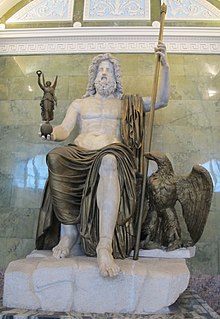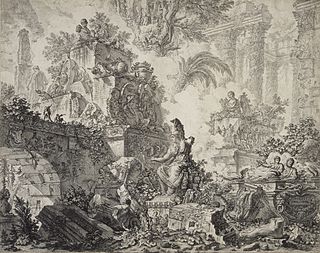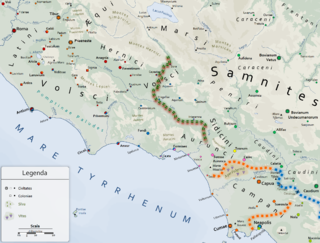
Jupiter, also known as Jove, is the god of the sky and thunder and king of the gods in ancient Roman religion and mythology. Jupiter was the chief deity of Roman state religion throughout the Republican and Imperial eras, until Christianity became the dominant religion of the Empire. In Roman mythology, he negotiates with Numa Pompilius, the second king of Rome, to establish principles of Roman religion such as offering, or sacrifice.

Festivals in ancient Rome were a very important part of Roman religious life during both the Republican and Imperial eras, and one of the primary features of the Roman calendar. Feriae were either public (publicae) or private (privatae). State holidays were celebrated by the Roman people and received public funding. Games (ludi), such as the Ludi Apollinares, were not technically feriae, but the days on which they were celebrated were dies festi, holidays in the modern sense of days off work. Although feriae were paid for by the state, ludi were often funded by wealthy individuals. Feriae privatae were holidays celebrated in honor of private individuals or by families. This article deals only with public holidays, including rites celebrated by the state priests of Rome at temples, as well as celebrations by neighborhoods, families, and friends held simultaneously throughout Rome.

A dictator was a magistrate of the Roman Republic, entrusted with the full authority of the state to deal with a military emergency or to undertake a specific duty. All other magistrates were subordinate to his imperium, and the right of the plebeian tribunes to veto his actions or of the people to appeal from them was extremely limited. In order to prevent the dictatorship from threatening the state itself, severe limitations were placed upon its powers, as a dictator could only act within his intended sphere of authority, and was obliged to resign his office once his appointed task had been accomplished, or at the expiration of six months. Dictators were frequently appointed from the earliest period of the Republic down to the Second Punic War, but the magistracy then went into abeyance for over a century, until it was revived in a significantly modified form, first by Sulla between 82 and 79 BC, and then by Julius Caesar between 49 and 44 BC. The office was formally abolished after the death of Caesar, and not revived under the Empire.

Alba Fucens was an ancient Italic town occupying a lofty location (1,000 m) at the foot of the Monte Velino, c. 6.5 km north of Avezzano, Abruzzo, central Italy. Its remains are today in the comune of Massa d'Albe.

The Baths of Titus or Thermae Titi were public baths (Thermae) built in 81 AD at Rome, by Roman emperor Titus. The baths sat at the base of the Esquiline Hill, an area of parkland and luxury estates which had been taken over by Nero for his Golden House or Domus Aurea. Titus' baths were built in haste, possibly by converting an existing or partly built bathing complex belonging to the reviled Domus Aurea. They were not particularly extensive, and the much larger Baths of Trajan were built immediately adjacent to them at the start of the next century.
The Ludi Romani was a religious festival in ancient Rome. Usually including multiple ceremonies called ludi. They were held annually starting in 366 BC from September 12 to September 14, later extended to September 5 to September 19. In the last 1st century BC, an extra day was added in honor of the deified Julius Caesar on 4 September. The festival first introduced drama to Rome based on Greek drama.
Clusium was an ancient city in Italy, one of several found at the site. The current municipality of Chiusi (Tuscany) partly overlaps this Roman walled city. The Roman city remodeled an earlier Etruscan city, Clevsin, found in the territory of a prehistoric culture, possibly also Etruscan or proto-Etruscan. The site is located in northern central Italy on the west side of the Apennines.

The Aurunci were an Italic tribe that lived in southern Italy from around the 1st millennium BC. They were eventually defeated by Rome and subsumed into the Roman Republic during the second half of the 4th century BC.

Gravisca was the port of the Etruscan city of Tarquinii, situated 8 km west of the city center.
Spurius Antius was one of four Roman envoys sent to Fidenae after it revolted against Roman rule and allied itself with the Etruscan city state of Veii. He, and the other Roman emissaries, were murdered on the orders of the King of Veii, Lars Tolumnius.

The Temple of Jupiter Stator was a temple of Ancient Rome in the southern Campus Martius. It was destroyed in 64 AD in the Great Fire of Rome.

Opus latericium is an ancient Roman construction technique in which coarse-laid brickwork is used to face a core of opus caementicium.

The Fasti Capitolini, or Capitoline Fasti, are a list of the chief magistrates of the Roman Republic, extending from the early fifth century BC down to the reign of Augustus, the first Roman emperor. Together with similar lists found at Rome and elsewhere, they form part of a chronology referred to as the Fasti Annales, Fasti Consulares, or Consular Fasti, or occasionally just the fasti.

In ancient Roman religion and myth, Mars was the god of war and also an agricultural guardian, a combination characteristic of early Rome. He was the son of Jupiter and Juno, and he was the most prominent of the military gods in the religion of the Roman army. Most of his festivals were held in March, the month named for him, and in October, which began the season for military campaigning and ended the season for farming.
The Sororium Tigillum, which translates as the "sister's beam", was a wooden beam said to have been erected on the slope of the Oppian Hill in Ancient Rome by the father of Publius Horatius, one of the three brothers Horatii. Publius Horatius was required to pass under the beam, as if under a yoke, following the decision of the people's assembly not to punish him for the murder of his sister.

In ancient Roman religion, the October Horse was an animal sacrifice to Mars carried out on October 15, coinciding with the end of the agricultural and military campaigning season. The rite took place during one of three horse-racing festivals held in honor of Mars, the others being the two Equirria on February 27 and March 14.

Ecetra was a town of the ancient Volsci tribe of central Italy. Its location is no longer known.

The Argiletum was a street in ancient Rome, which crossed the popular district of Suburra up to the Roman Forum, along the route of the current Via Leonina and Via della Madonna dei Monti.
Gaius Marcius Figulus was a politician of the Roman Republic who served as praetor in 169 BC, Roman consul in 162 BC, and again as consul in 156 BC. Upon being elected to the praetorship in 169 BC, Figulus received command of the Roman fleets by lot. Later that year, he transported the consul, Quintus Marcius Philippus, to Ambracia so that he could assume command of Roman forces fighting the Third Macedonian War. Figulus himself sailed on to Creusa, then crossed Boeotia by land in a single day to join the rest of the fleet at Chalcis. The only other mention Livy makes of Figulus is a reference to his having assigned part of the fleet to winter quarters at Sciathus, and the remainder at Oreum, in Euboea, which he judged the best location to maintain supply lines to the army in Macedon.

Aqua Crabra was a Roman aqueduct supplying villas in the hinterland of the ancient town of Tusculum.














